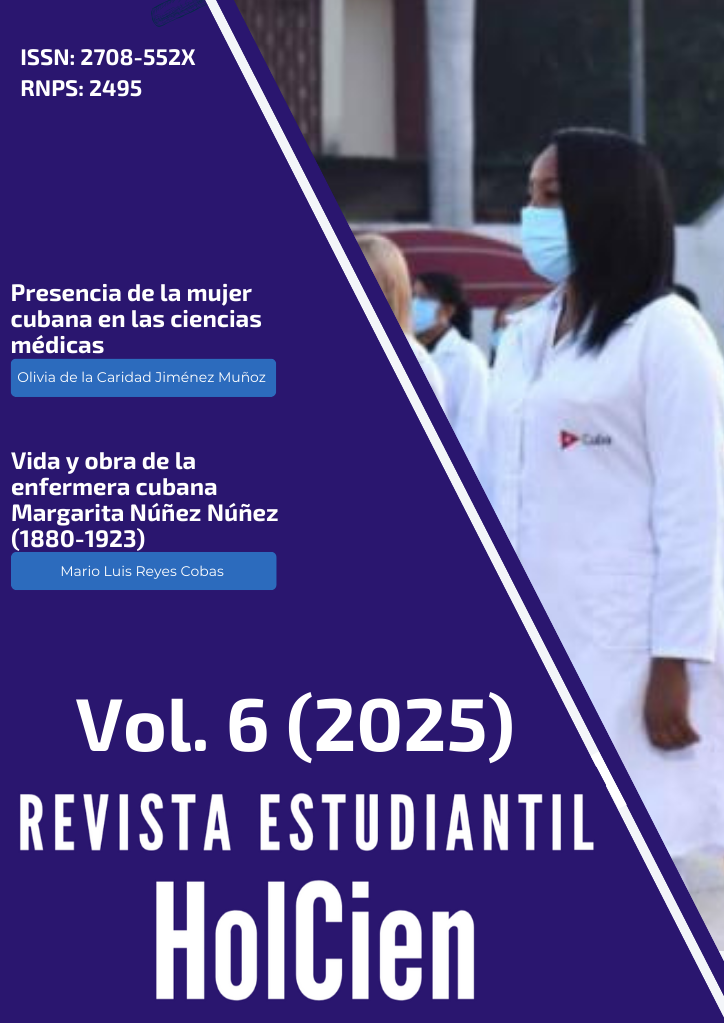Análisis de factores de riesgo asociados a la prematuridad
DOI:
https://doi.org/10.5281/zenodo.15449861Palabras clave:
factores de riesgo, parto pretérmino, prematuridadResumen
Introducción: La prematuridad es la primera causa de mortalidad neonatal y también entre los menores de cinco años de edad. Más de un millón de niños prematuros mueren cada año, pero muchos de los que sobreviven sufren algún tipo de discapacidad, en particular las relacionadas con el aprendizaje, problemas visuales y auditivos.
Objetivo: Caracterizar los factores de riesgo asociados a la prematuridad en el primer trimestre del 2023 en el municipio de Santiago de Cuba.
Método: Se realizó estudio descriptivo longitudinal retrospectivo, en pacientes prematuros durante el período enero – 24 de marzo de 2023 en el Municipio Santiago de Cuba. El universo estuvo conformado por los nacidos vivos en el Municipio Santiago de Cuba en el período descrito (1161 infantes), se escoge una muestra de 35 nacidos vivos prematuros mediante muestreo aleatorio simple.
Resultados: En el tiempo estudiado disminuyeron los partos pretérmino. La frecuencia de prematuridad fue similar en niños y niñas; la relación entre prematuridad y crecimiento intrauterino retardado se evidenció en un 48, 57 %. Las edades maternas extremas estuvieron presentes como factor de riesgo asociado a prematuridad en un 57, 1 %.
Conclusiones: El primer trimestre del 2023 se caracterizó por una disminución de la prematuridad con relación al año presente, los prematuros tardíos constituyeron el mayor número de casos. Se relacionan estrechamente el bajo peso al nacer y la prematuridad. Los factores maternos contribuyen en mayor medida a la aparición de este problema de salud, sobre toda la edad al momento de la concepción del embarazo.
Citas
Matos Alviso LJ, Reyes Hernández KL, López Navarrete GE, Reyes Hernández MU, Aguilar Figueroa ES, Pérez Pacheco O, et al. La prematuridad: epidemiología, causas y consecuencias, primer lugar de mortalidad y discapacidad. RevSalJal. 2020[citado 02/02/2024];7(3):179-186.Disponible en: https://www.medigraphic.com/pdfs/saljalisco/sj-2020/sj203h.pdf
de Rodríguez IC, Rossell-Pineda M del R, Álvarez de Acosta T, Rojas Quintero L. Factores de riesgo asociados a la prematuridad en recién nacidos de madres adolescentes. Rev Obstet Ginecol Venez.2013[citado 27/10/23];73(3):157-170.Disponible en: http://ve.scielo.org/scielo.php?script=sci_arttext&pid=S0048-77322013000300003&lng=es
Domínguez Dieppa F. La prematuridad: un problema pendiente de solución. Rev Cubana Pediatr.2021 [citado 27/10/23]; 93(1).Disponible en: https://revpediatria.sld.cu/index.php/ped/article/view/1435
Milián Espinosa I, Cairo Gonzáles VM, Silverio Negrín M, Benavides Casals ME, Pentón Cortes R , Marín Tápanes Y. Epidemiología del parto pretérmino espontáneo. Acta Méd Centro.2019;13(3).Disponible en: https://www.medigraphic.com/pdfs/medicadelcentro/mec-2019/mec193g.pdf
Mendoza Tascón LA, Claros Benítez DI, Mendoza Tascón LI, Arias Guatibonza MD, Peñaranda Ospina CB. Epidemiología de la prematuridad, sus determinantes y prevención del parto prematuro. Rev Chil Obstet Ginecol. 2016[citado 02/03/2024];81(4):330-342.Disponible en: https://www.scielo.cl/scielo.php?script=sci_arttext&pid=S0717-75262016000400012
Villanueva ELA, Contreras GAK, Pichardo CM, et al. Perfil epidemiológico del parto prematuro. Ginecol Obstet Mex. 2008[citado 05/07/2024];76(09):542-548.Disponible en: https://www.medigraphic.com/cgi-bin/new/resumen.cgi?IDARTICULO=19563
Fernández Borbón H, González Pi Y. Factores de riesgo asociados al parto prematuro, Policlínico Universitario “Hermanos Cruz”, 2022. Rev Ciencias Médicas.2023 [citado 05/02/2025];27(6).Disponible en: http://scielo.sld.cu/scielo.php?script=sci_arttext&pid=S1561-31942023000700016&lng=es
Díaz Molleda M, Puentes Rizo E, González Cárdenas LT. Caracterización de la población femenina con riesgo preconcepcional del municipio Arroyo Naranjo. Rev Cubana Med Gen Integr.2021[citado 25/08/2025];37(2). Disponible en: http://scielo.sld.cu/scielo.php?script=sci_arttext&pid=S0864-21252021000200014&lng=es
Zorrilla Quiñones AM, de la Cruz Pérez D. Factores asociados al bajo peso al nacer en el municipio Pinar del Río. Rev Ciencias Médicas.2020[citado 20/03/2025];24(5). Disponible en: http://scielo.sld.cu/scielo.php?script=sci_arttext&pid=S1561-31942020000500013&lng=es
Mora Vallejo M, Peñaloza D, Pullupaxi C, Díaz Rodríguez J. Infecciones del tracto urinario como factor de riesgo para parto prematuro en adolescentes embarazadas. FacSalud-Unemi. 2019;3(4):26-35.
Toro Huerta C, Vidal C, Araya Castillo L. Tendencia temporal y factores asociados al parto prematuro en Chile, 1992-2018. Salud Colect. 2023[citado 05/07/2024];19:e4203. Disponible en: https://www.scielosp.org/pdf/scol/2023.v19/e4203/es
Sánchez Orbe JO, Rodríguez Vargas N, Batista Garabitos DM, Hernández Castillo YN, Montesano Y. Factores de riesgo asociados al trabajo de parto pretérmino en gestantes del Hospital Universitario Maternidad Nuestra Señora de la Altagracia septiembre-diciembre 2018. Cienc Salud (St Domingo).2022[citado 05/08/2024];6(1):65-70]. Disponible en: https://revistas.intec.edu.do/index.php/cisa/article/view/2404/2781
Bachiller Roque Poma MC. Características clínico epidemiológicas de los recién nacidos prematuros tardíos en un hospital de Huancayo-2020 [Tesis].[Huancayo-Perú]: Universidad Peruana Los Andes;2022.91p.Disponible en: https://repositorio.upla.edu.pe/bitstream/handle/20.500.12848/4086/TESIS.ROQUE%20POMA%20%281%29.pdf?sequence=1&isAllowed=y
Bigolin Jantsch L, Teixeira Canto R, Martins de Melo A, Rinaldo Scaburi I , Nascimento Correa de Andrade E, Tatsch Neves E. Obstetric factors associated with birth of moderate and late premature babies. Enferm Glob. 2021 [citado 05/08/2024];20(61):23-58. Disponible en: http://scielo.isciii.es/scielo.php?script=sci_arttext&pid=S1695-61412021000100002&lng=es
Teixeira GA, de Carvalho JBL, da Rocha BG, Pereira SA, Enders BC. Perfil de mães e o desfecho do nascimento prematuro ou a termo. Cogitare Enferm.2018 [citado 05/02/ 2025];23(1). Disponible en: https://revistas.ufpr.br/cogitare/article/view/51409
Toro Huamanchumo CJ, Barboza Joshuan J, Pinedo Castillo L, Barros Sevillano S, Gronerth Silva JK , Galvez Díaz NC, et al . Factores maternos asociados a prematuridad en gestantes de un hospital público de Trujillo, Perú. Rev Cuerpo Med HNAAA. 2021 [citado 06/08/2024];14(3):287-290. Disponible en: http://www.scielo.org.pe/scielo.php?script=sci_arttext&pid=S2227-47312021000400006&lng=es
Ahumada JS, Barrera AM, Canosa D, Cárdenas L, Uriel M, Ibáñez EA, et al. Factores de riesgo de parto pretérmino en Bogotá D.C., Colombia. Rev Fac Med.2020[citado 05/08/2024];68(4):556-563. Disponible en: http://www.scielo.org.co/scielo.php?script=sci_arttext&pid=S0120-00112020000400556&lang=es
Publicado
Cómo citar
Número
Sección
Licencia
Derechos de autor 2025 Revista Estudiantil HolCien

Esta obra está bajo una licencia internacional Creative Commons Atribución-NoComercial 4.0.
Centro Provincial de Información de Ciencias Médicas. Universidad de Ciencias Médicas de Holguín. Cuba.
Política de acceso y distribución
El total de los artículos publicados son contribuciones de acceso abierto, que se distribuyen según los términos de la Licencia Creative Commons Atribución–NoComercial 4.0 que permite el uso, distribución y reproducción no comerciales y sin restricciones en cualquier medio, siempre que sea debidamente citada la fuente primaria de publicación.





